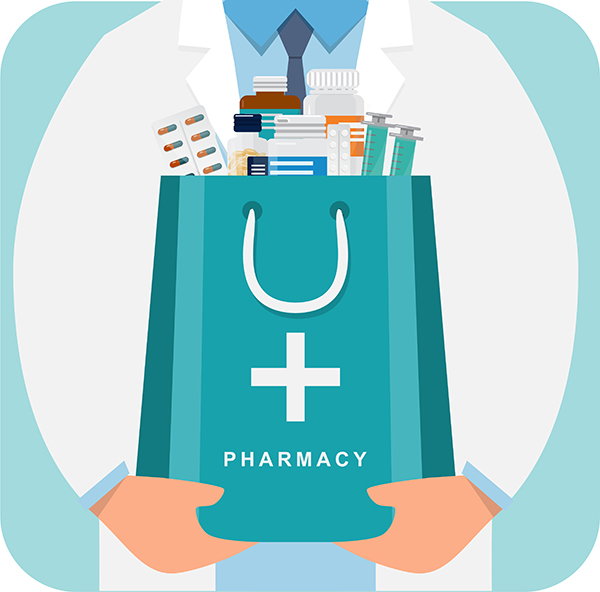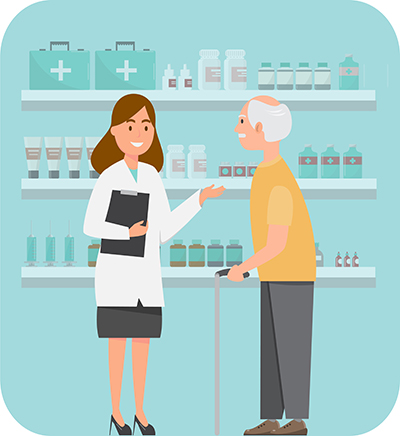The expanding role of pharmacies in biotherapies


In 1990, researchers at the National Institutes of Health (NIH) performed the first human gene therapy trial, using retroviral-mediated transfer of the adenosine deaminase (ADA) gene into the T cells of two children via ex vivo modification with severe combined immunodeficiency.1 The successful results marked a significant milestone in biotherapies and laid the groundwork for future gene therapy experiments and clinical trials.
Since then, cell and gene therapies (CGTs) have made significant strides, demonstrating remarkable potential to treat a wide range of conditions and genetic disorders, including blood cancers, diabetes, autoimmune diseases and sickle cell disease (SCD). To date, the United States Food and Drug Administration (FDA) has approved 43 CGTs, with 15 products receiving approval in the last two years.2
“When I first entered the profession, we were only treating symptoms,” stated Eric Manuel Balmir, MS, PharmD, CIM, vice president of clinical ancillary services and chief pharmacy officer at Children's National Hospital. “People were dying from AIDS, but now they’re surviving. We've shifted from simply treating symptoms to prolonging life, and now we're entering an exciting new phase focused on providing cures. We're shaping the future. We're going to transform health care and the way it is delivered. The possibilities are endless.”
As the landscape of biotherapies continues to evolve, pharmacies are playing an increasingly vital role in the delivery and management of approved CGT products. A review of existing pharmacy quality programs and available certifications revealed a lack of standards specific for handling and managing CGTs within the field of pharmacy. To address this gap in quality assurance, AABB has launched the new Cell and Gene Therapy Standards and Accreditation program for Pharmacy—the first accreditation tailored to pharmacies that dispense approved CGT products. The concept for pharmacy-specific standards emerged through early conversations with leaders like Kim Tedesco, director of gene and cell pharmacy operations, Walgreens Gene and Cell Services, who helped highlight the critical need for guidance in this space. The resulting program establishes comprehensive quality systems to guide pharmacies in the receipt, storage, handling, and dispensing of these therapies, ultimately enhancing patient safety.
Krystal Haynes, director of business development at Cencora and a contributor to the AABB CGT Standards for Pharmacy, underscores the importance of establishing a robust framework that encompasses the entire product journey. “The standards provide a comprehensive approach that must remain adaptable to the shifting geopolitical factors influencing reimbursement and FDA operations,” Haynes remarked.
Tedesco noted that pharmacies are well-positioned to be at the center of the evolving gene and cell product landscape due to their deep-rooted history of managing complex therapies and patient care and longstanding experience in navigating payer and reimbursement issues.
“When a patient is dealing with a potentially life-threatening disease, and you add the complexity of gene and cell therapy, it requires close collaboration with oncologists, gene experts, payers, case managers and social workers,” Tedesco said. “It’s critical that all key stakeholders are on the same page, working together to support the patient’s journey. At Walgreens, we’ve placed ourselves at the center of this collaboration to ensure patients feel supported.”

In 2024, Walgreens expanded its specialty pharmacy services to integrate gene and cell therapies into its operating model. The company opened a dedicated 18,000 square-foot gene and cell pharmacy and innovation center in Pittsburgh, Pa., with services to support emerging therapies, including solutions for handling clinical management, supply chain logistics, financing and the complexities of therapy administration. The facility also offers an interactive workspace where teams and vendors can collaborate to address patient needs and solve challenges in therapy.
“We planned for the future from the beginning,” Tedesco said. “Our conversations about gene and cell therapies within Walgreens began five years ago, and we’ve been intentional in how we’ve approached it. Before we entered the market, we wanted to make sure we understood the field and challenges patients face to provide solutions for those barriers.” To that end, Walgreens provides specialized training for its pharmacy teams to handle different types of CGT products, including fresh, ultra-cold and cryopreserved, to ensure understanding of product-specific requirements and follow-up care.
“We didn’t just roll gene and cell therapies into our specialty business; we carved out a dedicated space for it because we knew it would require collaboration and different skill sets,” Tedesco said. “We created this space purposefully, and we are fully equipped to support all aspects of gene and cell therapies. Our Pittsburgh facility was built with scalability in mind to meet the growing demand for gene and cell therapies and help patients access these life-changing therapies.”
As one of the few pediatric hospitals in the country offering FDA-approved sickle cell disease gene therapies and a pediatric cellular therapy program, Children’s National is leading the way in gene therapy clinical trials and research. Balmir discussed his institution's vital role in precision dispensing, using pharmacogenomics to ensure drugs are tailored to individual patients particularly in pediatric care.
“I’m fortunate to be part of an investigational drug service division, where we are at the forefront of innovation and creation. We can minimize side effects from drugs based on how well they work for specific populations. For example, we can determine which drugs are more effective for Asian patients or less effective for Black patients,” Balmir explained. “Pharmacists are in a unique position to understand how certain blood indicators can guide us in selecting drugs and products that are best suited for each person, offering a more individualized approach to treatment based on these studies."
Tedesco has witnessed firsthand the transformative power of CGTs and is passionate about ensuring patient access. She cited the absence of education across the entire health care ecosystem as a major barrier. “It’s crucial to ensure that all stakeholders understand not only that these therapies are available, but also the pathway to access them. Walgreens is at the forefront of educating patients and health care stakeholders about the steps required to receive these therapies,” she said.
Balmir shared the same perspective for the pediatric patient population. “Education is a unique challenge pharmacies face in delivering advanced therapies to children, especially when these therapies are novel or experimental,” he said. “Specifically, the education surrounding the novelty of these therapies can be a significant hurdle. Parents often find themselves desperate for cures, and unfortunately, not all patients meet the criteria to receive these therapies. This can be a difficult and emotional situation for both the families and the health care providers.”
In addition to educating families about the financial and health benefits of therapies, pharmacies can identify potential candidates for gene therapy and help patients navigate insurance hurdles, Balmir pointed out.
“We see ourselves as the scouts because we’re the ones already treating patients with chronic conditions, such as SCD, and managing their medications. But it doesn’t stop there. We need to figure out if they meet the criteria and then determine whether their insurance will cover it,” Balmir told AABB News. Sometimes, he said, this involves lengthy, two-month-long conversations with insurance companies to prove that spending $2.3 million upfront for the treatment will save money in the long run.
“The problem is, most payers’ financial outlooks are only one year, not ten. But with gene therapies, that’s starting to change,” Balmir said. “We need to shift toward a long-term economic outlook when evaluating the cost-effectiveness of these therapies, and pharmacies are in the unique position to provide the data and education needed to help families navigate this process and maintain long-term care.”
“We must ensure that these therapies reach the populations that need them most. Many of these therapies are prohibitively expensive, and it is not feasible to simply distribute them without careful consideration.” – Krystal Haynes
A fundamental aspect of these standards is ensuring that all stakeholders involved in the therapy process—whether in manufacturing, handling or delivery—are adequately trained, certified and competent. As the number of approved therapies continues to grow and more therapies enter clinical trials, the guidance established today will be instrumental in shaping the future of biotherapy distribution. “It is essential that those leading this initiative actively promote it to support organizations within the field,” Haynes emphasized.
However, the path to scaling these therapies for larger patient populations presents significant challenges. Haynes highlighted critical issues such as limited sites of care and socioeconomic barriers that can impede access for underserved communities. “We must ensure that these therapies reach the populations that need them most. Many of these therapies are prohibitively expensive, and it is not feasible to simply distribute them without careful consideration,” she stated. Leaders in the field are actively developing mitigation strategies to enhance access while upholding the high standards required for managing these complex therapies.
To effectively manage gene therapies, pharmacies must also invest in new operational capabilities and partnership. Although manufacturers often prefer to collaborate with specialty pharmacies for these treatments, retail pharmacies are gradually integrating them into their specialty offerings, albeit with scalability challenges. “From my perspective, there is a growing intersection between third-party logistics providers and pharmacies. Healthcare companies are forming partnerships, but there remains a pressing need for standardized guidance regarding logistics, distribution, pharmacy and site of care collaborations,” Haynes noted.
Looking ahead, Haynes advocates for the expansion of pharmacies and care sites equipped to handle biotherapies effectively. “The goal is to maintain segregation of duties while ensuring efficient throughput, which is a current challenge,” she said. As the industry advances, it will be essential to adapt guidance to accommodate multiple products per pharmacy, thereby enhancing scalability and ensuring that innovative therapies are accessible to all patients in need.

The rapid growth of gene therapies requires strong regulatory standards to ensure safety, traceability and long-term monitoring. Tedesco mentioned Walgreens’ goal to be a leader in the rapidly growing field by collaborating with regulatory agencies and stakeholders like AABB. Given the high cost of these therapies, specialty pharmacies are equipped to navigate the financial and reimbursement complexities of gene and cell therapies, she added.
“The field is moving quickly, with more than 1,500 products in clinical trials, and as more products become available commercially, it’s clear that pharmacies will play an integral role,” Tedesco said. “We want to be leaders in this space. We aim to drive the entire field forward and ensure patients have access to these life-saving treatments.”
Balmir and Tedesco, members of the AABB Cell and Gene Therapy Services for Pharmacy Standards Committee, lauded AABB for setting new quality standards to ensure safe and effective delivery and maintain the integrity of gene and cell therapies.
“There hasn’t been any true pharmacy accreditation specifically for gene and cell therapies until now, and given the complexity and fragility of these products, having standards is critical,” Tedesco told AABB News. “The work AABB has done to create these standards is vital for the field.”
Moreover, tracking the effects of gene therapy without standardized guidelines would be challenging, particularly when changes in genetic sequences may cause unforeseen consequences, such as altered intelligence or late-onset diseases, Balmir added.
“Establishing clear quality standards creates a pathway to accelerate the introduction and implementation of other drugs. Without AABB setting guidelines, the process would be delayed,” Balmir said. “Our primary focus at Children’s Hospital is ensuring these processes are handled correctly and efficiently behind the scenes. By developing an educational platform and creating a checklist and an oversight document for each therapy, we were able to maintain our high standards and ensure consistent quality in how we use CGT products.”
As the AABB CGT pharmacy standards become more widespread across the health care system, Balmir predicts the role of pharmacies will evolve to ensure better care, adherence and safety in the administration of these therapies.
“Looking ahead, I believe these standards will eventually be adopted by the Departments of Health of respective states and even nationally by the Joint Commission. This will lead to greater consistency and safety in the handling of advanced therapies, benefiting patients and health care providers alike,” Balmir stated.
Tedesco expressed her excitement about Walgreens' role in the evolution of gene and cell therapies and the company's collaboration with AABB in shaping the field’s standards.
“As more CGT products hit the market, pharmacy involvement will grow, and having clear standards will ensure these therapies are delivered safely and effectively,” Tedesco said. “Walgreens is committed to integrating them into our workflow. AABB has been a great partner in creating pharmacy standards, and we believe these standards will be beneficial to the entire pharmacy industry.”
Haynes also acknowledged the dedicated efforts of all volunteers involved in developing the new quality standards, including FDA representatives, health care professionals and pharmacy stakeholders. “It has been immensely rewarding to contribute to the design of these pharmacy standards. I take pride in the collective effort of everyone involved,” Haynes stated. “I wish to extend my heartfelt gratitude to the team for their hard work. The committee's commitment and collaborative spirit were pivotal in creating a framework that will have a lasting impact on our field.”
References
R. Michael Blaese et al. T Lymphocyte-Directed Gene Therapy for ADA− SCID: Initial Trial Results After 4 Years. Science 270,475-480(1995). DOI:10.1126/science.270.5235.475
Center for Biologics Evaluation and Research. (2025, March 6). Approved cellular and gene therapy products. U.S. Food and Drug Administration. fda.gov/vaccines-blood-biologics/cellular-gene-therapy-products/approved-cellular-and-gene-therapy-products
BACK TO ISSUE
April 2025NEXT STORY
The Power of Unity
Transfusion is AABB’s scholarly, peer-reviewed monthly journal, publishing the latest on technological advances, clinical research and controversial issues related to transfusion medicine, blood banking, biotherapies and tissue transplantation. Access of Transfusion is free to all AABB members.
Learn More About Transfusion Journal
Keep abreast of what's happening in the field of biotherapies with CellSource - AABB's monthly update on the latest biotherapies news.
To submit news about the blood and biotherapies field to AABB, please email news@aabb.org.
President
Meghan Delaney, DO, MPH
Chief Executive Officer
Debra Ben Avram, FASAE, CAE
Chief Communications and Engagement
Officer Julia Zimmerman
Director of Marketing and Communications
Jay Lewis, MPH
Managing Editor
Kendra Y. Mims, MFA
Senior Communications Manager
Drew Case
AABB News
(ISSN 1523939X) is published monthly, except for the combined November/December issue for the members of AABB; 4550 Montgomery Avenue; Suite 700 North Tower; Bethesda, MD 20814.
AABB is an international, not-for-profit association representing individuals and institutions involved in transfusion medicine, cellular therapies and patient blood management. The association is committed to improving health by developing and delivering standards, accreditation and educational programs that focus on optimizing patient and donor care and safety.
+1.301.907.6977
Email: news@aabb.org
Website: www.aabb.org
Copyright 2025 by AABB.
Views and opinions expressed in AABB News are not necessarily endorsed by AABB unless expressly stated.
Notice to Copiers: Reproduction in whole or part is strictly prohibited unless written permission has been granted by the publisher. AABB members need not obtain prior permission if proper credit is given.